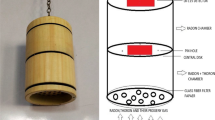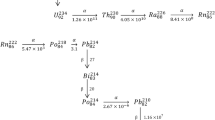Abstract
Indoor radon activity concentrations were carried out using twin cup dosimeters with SSNTDs in four districts viz., Karimnagar, Peddapalli, Jagtial and Rajanna Sircilla of Telangana state, India. The part of study area falls under Karimnagar Granulite Terrain, the geological region recognized for the occurrence of high uranium content metasedimentary enclaves within granite. The radon concentrations, in the study area, were found to vary from 7 to 457 Bq m−3 with a geometric mean of 62 Bq m−3 (GSD 2.24). The estimated radon activity is observed to obey log-normal distribution. The analysis of seasonal variation confirmed that the indoor radon concentration levels are relatively higher in the winter. Variation of radon activity levels in dwellings with different types of building materials was also studied and presented in this paper.






Similar content being viewed by others
References
United Nations Scientific Committee on the Effects of Atomic Radiation (UNSCEAR) (2019) Sources and effects of ionizing radiation. Report to the general assembly with scientific annexes. United Nations, New York
Darby S, Hill D, Auvinen A, BarrosDios JM, Baysson H, Bochicchio F et al (2005) Radon in homes and risk of lung cancer: collaborative analysis of individual data from 13 European case-control studies. BMJ 330:22. https://doi.org/10.1136/bmj.38308.477650.63
World Health Organization (2009) WHO handbook on indoor radon: a public health perspective. World Health Organization, Geneva
ICRP (2014) Radiological Protection against Radon Exposure. ICRP Publication 126. Ann. ICRP 43(3).
Giustini F, Ciotoli G, Rinaldini A, Ruggiero L, Voltaggio M (2019) Mapping the geogenic radon potential and radon risk by using Empirical Bayesian Kriging regression: a case study from a volcanic area of central Italy. Sci Total Environ 661:449–464. https://doi.org/10.1016/j.scitotenv.2019.01.146
Choubey VM, Sharma KK, Ramola RC (1997) Geology of radon occurrence around Jari in Parvati valley, Himachal Pradesh, India. J Environ Radioact 34(2):139–147. https://doi.org/10.1016/0265-931X(96)00024-0
Ademola JA (2008) Determination of natural radionuclides content in some building materials in Nigeria by gamma-ray spectrometry. Health Phys 94(1):43–48. https://doi.org/10.1097/01.HP.0000279601.26386.af
Kandari T, Aswal S, Prasad M, Pant P, Bourai AA, Ramola RC (2016) Study of radiation exposure due to radon, thoron and their progeny in the indoor environment of Rajpur region of Uttarakhand Himalaya. Radiat Prot Dosim 171(2):204–207. https://doi.org/10.1093/rpd/ncw059
Yadagiri Reddy P, Vinay Kumar Reddy K, Gopal Reddy C, Reddy R, K (2005) Indoor radiation levels in the proposed uranium mining areas of Andhra Pradesh, India. Environ Geochem 8(1–2):104–107
Villalba Espinosa P, Hidalgo García D, Arco Díaz J, Villalba Moreno J (2020) Study of Radon concentrations in a single-family home and their relationship with the ventilation system. Revista de la construcción 19(3):443–456
Suman G, Vinay Kumar Reddy K, Sreenath Reddy M, Reddy G, Ch, Reddy Y (2021) Radon and thoron levels in the dwellings of Buddonithanda: a village in the environs of proposed uranium mining site, Nalgonda district, Telangana state, India. Nat Sci Rep 11(1):1–9. https://doi.org/10.1038/s41598-021-85698-1
Narasimhamurthy KN, Ashok GV, Shasi Kumar TS, Nagaiah N (2020) The 222Rn and 220Rn concentrations in some dwellings of Mandya city and its surroundings, Karnataka, India. Indoor Built Environ. https://doi.org/10.1177/1420326X20931590
Yarmoshenko I, Malinovsky G, Vasilyev A, Zhukovsky M (2018) Method for measuring radon flux density from soil activated by a pressure gradient. Radiat Meas 119:150–154. https://doi.org/10.1016/j.radmeas.2018.10.011
Prakash D, Sharma IN (2011) Metamorphic evolution of the Karimnagar granulite terrane, Eastern Dharwar Craton, south India. Geol Mag 148(1):112–132
Som A, Baba MS, Jeyagopal AV, Shobhita K, Mohanty R, Maithani PB (2010) Occurrence of uranium in metasedimentary enclaves within basement granite, near Peddur and Kottur, Karimnagar district, Andhra Pradesh. J Geol Soc India 76(3):247–250. https://doi.org/10.1007/s12594-010-0100-2
Ningappa C, Sannappa J, Chandrashekara MS, Paramesh L (2009) Studies on radon/thoron and their decay products in granite quarries around Bangalore city, India. Indian J Phys 83(8):1201–1207. https://doi.org/10.1007/s12648-009-0102-3
Sannappa J, Ningappa C (2014) Indoor concentration of radon, thoron and their progeny around granite regions in the state of Karnataka, India. Radiat Prot Dosim 4:406–411. https://doi.org/10.1093/rpd/nct243
Frank AL, Benton EV (1977) Radon dosimetry using plastic nuclear track detectors. Nucl Track Detect 1(3–4):149–179. https://doi.org/10.1016/0145-224X(77)90011-4
Fleischer RL, Giard WR, Mogro-Campero A, Turner LG, Alter HW, Gingrich JE (1980) Dosimetry of environmental radon: methods and theory for low-dose, integrated measurements. Health Phys 39(6):957–962. https://doi.org/10.1097/00004032-198012000-00009
Mayya YS, Eappen KP, Nambi KSV (1998) Methodology for mixed field inhalation dosimetry in monazite areas using a twin-cup dosemeter with three track detectors. Radiat Protect Dosim 77(3):177–184. https://doi.org/10.1093/oxfordjournals.rpd.a032308
Jojo PJ, Khan AJ, Tyagi RK, Ramachandran TV, Ramu MS, Prasad R (1994) Interlaboratory calibration of track-etch detectors for the measurement of radon and radon daughter levels. Radiat Meas 23(4):715–724. https://doi.org/10.1016/1350-4487(94)90008-6
Nazir S, Sahoo BK, Rani S et al (2021) Radon mapping in groundwater and indoor environs of Budgam, Jammu and Kashmir. J Radioanal Nucl Chem. https://doi.org/10.1007/s10967-021-07856-z
Srinivas Reddy G, Vinay Kumar Reddy K, Sreenivasa Reddy B, Linga Reddy B, Sreenath Reddy M, Gopal Reddy Ch, Chand Yadagiri Reddy P (2021) Thoron concentrations in certain northern districts of Telangana, India. In: AIP conference proceedings (In press)
Daraktchieva Z, Miles JCH, McColl N (2014) Radon, the lognormal distribution and deviation from it. J Radiol Prot 34(1):183–190. https://doi.org/10.1088/0952-4746/34/1/183
Reddy VK, Reddy KSreenivasa, Linga Reddy B (2020) Natural background gamma radiation levels in dwellings constructed under the Double Bedroom Housing Scheme at Erravalli and Narasannapet model villages of Telangana state, India. Indoor Built Environ 29(7):1038–1044. https://doi.org/10.1177/1420326X19865998
Sreenivasa Reddy B, Sreenath Reddy M, Reddy G. Reddy CYadagiri, P and Rama Reddy K (2003) Airborne radioactivity levels in dwellings of Khammam district, Andhra Pradesh, India. Radiat Meas 36(1–6):503–506. https://doi.org/10.1016/S1350-4487(03)00190-2
Sreenath Reddy M, Reddy Y, Rama ReddyEappen PK, Ramachandran KP, Mayya YS (2008) Indoor radon levels in urban Hyderabad area, Andhra Pradesh, India. Radiat Protect Dosim 132(4):403–408. https://doi.org/10.1093/rpd/ncn311
Linga Reddy, Srinivas Reddy B, Vinay Kumar Reddy G, Reddy KSreenivasa (2021) Inhalation dose due to residential radon and thoron exposure in rural areas: a case study at Erravalli and Narasannapet model villages of Telangana state, India. Rad Env 60:437–445. https://doi.org/10.1007/s00411-021-00912-y
Singh P, Singh P, Singh S, Sahoo BK, Sapra BK, Bajwa BS (2015) A study of indoor radon, thoron and their progeny measurement in Tosham region Haryana, India. J Radiat Res Appl Sci 8(2):226–233. https://doi.org/10.1016/j.jrras.2015.01.008
Niranjan RS, Ningappa C, Yashaswini T (2018) Concentration of radon in dwellings of Hemavathi river basin, Karnataka, India. Radiat Protect Dosim 181(3):269–276. https://doi.org/10.1093/rpd/ncy023
Ramola RC, Prasad M, Kandari T, Pant P, Bossew P, Mishra R, Tokonami S (2016) Dose estimation derived from the exposure to radon, thoron and their progeny in the indoor environment. Sci Rep 6(1):1–16. https://doi.org/10.1038/srep31061
Chauhan RP, Nain M, Kant K (2008) Radon diffusion studies through some building materials: effect of grain size. Radiat Meas 43:S445–S448. https://doi.org/10.1016/j.radmeas.2008.03.013
Vinay Kumar Reddy K, Reddy G, Sagar CVidya, Yadagiri Reddy D, Rama Reddy P (2012) Environmental radioactivity studies in the proposed Lambapur and Peddagattu uranium mining areas of Andhra Pradesh, India. Radiat Protect Dosim 151(2):290–298. https://doi.org/10.1093/rpd/ncs005
Vinay Kumar Reddy SG, Sreenath Reddy K, Reddy MGopal Ch, Reddy YP (2020) Indoor radon and thoron in the vicinity of proposed uranium mining site: a case study at Dasarlapally village, Telangana State, India. Radiat Protect Dosim 189(2):205–212. https://doi.org/10.1093/rpd/ncaa032
Acknowledgements
The authors are grateful to Prof. K. Rama Reddy for his inspiring discussion and kind support during the research work. Also, authors (GSR KVR BSR and BLR) are most thankful to management of CBES/CBITS and Principals of both MGIT and CBIT colleges for their encouragement and support in carrying out the research work.
Author information
Authors and Affiliations
Corresponding author
Additional information
Publisher’s Note
Springer Nature remains neutral with regard to jurisdictional claims in published maps and institutional affiliations.
Rights and permissions
About this article
Cite this article
Srinivas Reddy, G., Vinay Kumar Reddy, ., Sreenivasa Reddy, B. et al. Assessment of indoor radon activity concentration levels in four northern districts of Telangana state, India. J Radioanal Nucl Chem 330, 1417–1423 (2021). https://doi.org/10.1007/s10967-021-07929-z
Received:
Accepted:
Published:
Issue Date:
DOI: https://doi.org/10.1007/s10967-021-07929-z




